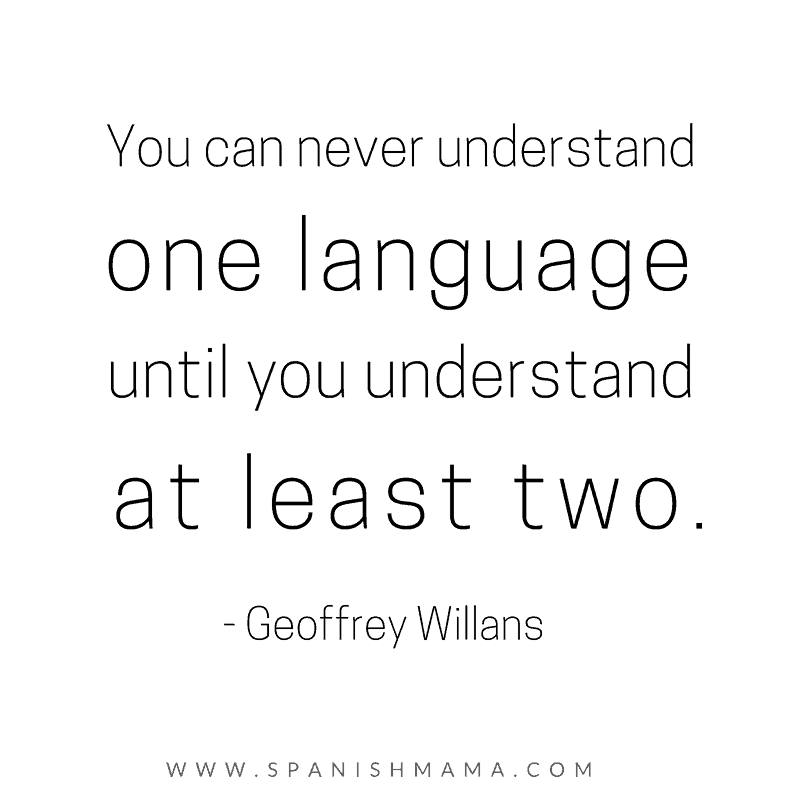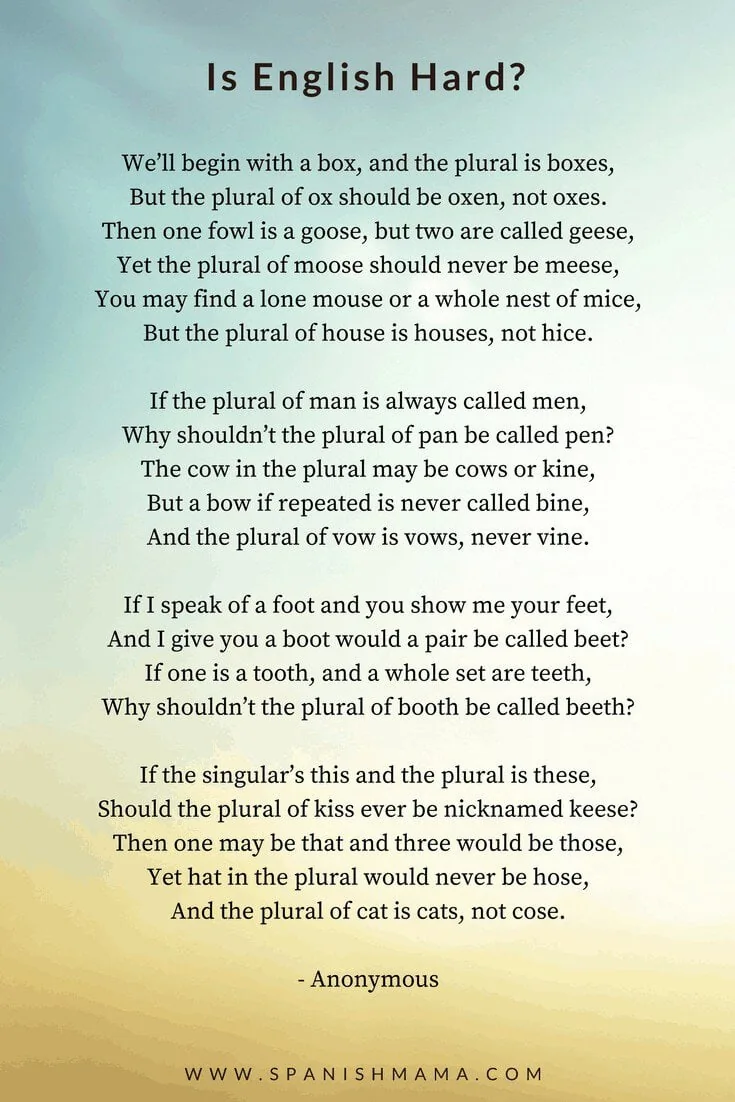Spanish vs. English: Which is Easier to Learn?
Inside: Spanish vs. English– which one is easier to learn?
My husband and I have a long-standing spat. He’s a native Spanish speaker who likes to complain about how weird and hard English is. I’m always quick to point out how hard and complicated Spanish grammar is.
I’m not sure if we are really arguing over facts; it may be we really just want the other person to understand what’s hard about speaking their language. Perhaps we mean to say: Do you see how hard I’m working to speak YOUR language?
Either way, we’re all fairly blind to the complications of our native languages. This is one of the reasons it’s valuable to study a second language: we develop more self-awareness, and hopefully a whole lot more empathy for immigrants and friends learning our language.

That self-awareness is a side-goal of my classes, and I like to show this clip early in the year. It’s a fun reminder that English only seems easy because they unconsciously learned it and use it. (As an aside, I aim for a similar “unconscious” experience and ease in acquisition in my Spanish classes— to the degree it’s possible with older students.)
But back to English vs. Spanish.
Social media informalIy tells me there’s an overwhelming consensus: English is WAY harder for Spanish-speakers to learn. I’ll concede that the erratic nature of English is obvious. You don’t have to look far for examples:

I think people are right that English is harder, but it is really WAY HARDER than Spanish? Let’s do our best to find out.
(I doubt this will be a conclusive post. When I decided to research, obviously I starting by googling around. The first two or three pages were almost entirely posts by companies selling language-learning materials. If you have a more scientific, research based article lying around, PLEASE let me know.)
So: IF you’re interested in an amateur examination of Spanish vs. English, read on.
WORD COUNT: SPANISH VS. ENGLISH
Which language has more words?
“There is no single sensible answer to this question. It’s impossible to count the number of words in a language, because it’s so hard to decide what actually counts as a word. Is dog one word, or two (a noun meaning ‘a kind of animal’, and a verb meaning ‘to follow persistently’)?” – Oxford Dictionary
Ok, but can we roughly estimate word counts?
“The Second Edition of the 20-volume Oxford English Dictionary contains full entries for 171,476 words in current use, and 47,156 obsolete words. To this may be added around 9,500 derivative words included as subentries.” – Oxford Dictionary
“Current editions of the Diccionario de la Real Academia Española (the dictionary of the Royal Spanish Academy), the closest thing there is to an official list of Spanish vocabulary, has around 88,000 words. In additional, the Academy’s list of americanismos includes about 70,000 words used in one or more Spanish-speaking countries of Latin America. So to round things off, figure there are around 150,000 “official” Spanish words.” – ThoughtCo.
Approximately (and according to the scant information I could find), English has about 180,000 words in the dictionary and Spanish has about 150,000. You generally use more words to express something in Spanish (English is more grammatically dense):
“…a 300-word document in English will typically be 350 or 400 words in Spanish.’ – Transfluent
How useful are these numbers? I’m not sure. I think the more relevant numbers are how many high-frequency words a native speaker depends on in a day, and I couldn’t track that info down.
PHONETICS: SPANISH VS. ENGLISH
Historically, Spanish takes foreign words and applies Spanish rules: people here say Goo-glay and Che-vro-let. (Though I wonder if this will change with the advent of social media– “selfie,” anyone?) English, on the other is a mish-mash of Anglo-French and Germanic influences, and evolved significantly from Old English into Modern English. We maintain French rules, for example, when we say She-vro-lay.
Basically, Spanish is a lovely and perfectly phonetic language. English, on the other hand, is VERY hard to read, pronounce, and write. Spanish has 25 phonemes; it’s generally agreed that English has 44 phonemes. (Phonemes are speech sounds.)
So it’s generally harder for a Spanish speaker to pronounce English well. It means learning entirely new sounds. While the English speaker will need to learn “rr” and nuances like “b” and “v,” Spanish speakers have a longer list. “Th” and new vowels sounds are particularly difficult.
Writing and reading is difficult in English, even for native speakers. Consider that the sound /sh/ can be represented by all of the following: sh, ce, s, ci, si, ch, sci, and ti.
I remember learning Spanish in Peru and being very frustrated when I would ask for the spelling of a word. Instead of spelling it, my friends would just enunciate the word again: sim-pá-ti-co. I guess there’s a reason Spelling Bees aren’t a big thing in Spanish.
One more point that sort of fits here:
“Do you ever feel like speakers of foreign languages are talking really, really fast? If you feel this way about Spanish or Japanese, you’re correct! These two languages were spoken faster than the others, at a rapid 7.82 and 7.84 syllables per second, respectively. On the other end of the spectrum, English and Mandarin Chinese were relatively slow, at 6.19 and 5.18 syllables per second, respectively.” – Transfluent
So while it’s easier to write and read in Spanish, it’s fair to say that listening to spoken Spanish is hard.
GENERAL GRAMMAR: SPANISH VS. ENGLISH
In terms of general grammar rules, English rules seem harder explain or “make sense of.” Spanish rules are more formulaic but still may take a long time to master.
THINGS THAT MAKE SPANISH HARD:
Gendered Nouns. On the surface, this is fairly easy to explain: masculine vs. feminine, and here are the exceptions. But it really means knowing the gender of EVERY noun, and applying this knowledge in almost EVERY sentence. It’s a huge extra “layer” that you don’t have to worry about in English.
THINGS THAT MAKE ENGLISH HARD:
Order of adjectives. Most English speakers probably aren’t aware of this, but there’s a strict order of adjectives. You can say “She was a beautiful young French woman,” but it would sounds strange to say “She was a French young beautiful woman.”
Negation. In Spanish, a “no” in front of the word usually does the trick. In English, there are a variety of pre-fixes to choose from: “un-,” “dis-,” “in-,” and “non-.” Negatives go together in Spanish as well (“No quiero nada”), while we mix them in English.
VERBS: SPANISH VS. ENGLISH
This is where Spanish gets significantly more complicated than English. Spanish has 14 complete paradigms for verbs– seven simple tenses, and seven compound tenses.
REGULAR VERBS
I think the numbers speak for themselves here. To conjugate the regular verb bailar in Spanish, I counted 56 different verb forms. (Correct me if I’m wrong, hehe. It took several counts. ) In English, I counted 4 (dance, dances, danced, dancing).
IRREGULAR VERBS
Ser: 48. (soy, fui, era, seré, sido, fuera, fuese, fuese, sé, seas, etc.)
To be: 8. (am, is, are, was, were, being, been, be).
THE SUBJUNCTIVE
The subjunctive mood isn’t a big deal in English, and generally follows the indicative verb forms. “I hope you get well soon,” “I hoped you would get well soon.” (“I wish _____” is a notorious exception.) In Spanish, however, it introduces an entirely new set of endings– including present, past, and future in the subjunctive. “Espero que te mejores pronto,” and “Esperaba que te mejoraras.”
THE IMPERATIVE
The imperative in Spanish means two new sets of verb endings, for positive and negative commands. In English, a positive command is the same as in the indicative, and a negative is formed by putting “don’t” at the front.
CONCLUSION ON SPANISH VS. ENGLISH
My sense is that Spanish is more formulaic: it lends itself better to charts and logical explanations. However, the grammar is quite extensive. There are many who will reach intermediate proficiency quickly, and sound extremely natural. Those people might still struggle to express very complex ideas, even after massive input. I suspect Spanish is more quickly comprehensible. Even though learners may not produce highly accurate verb forms, they can grab onto the “stem” and make sense of it.
English, due to its origins, is more erratic. The rules are quite complex in a sense (especially when it comes to phonetics), but with no gendered nouns and few verb endings. It will be harder to sound like a natural in writing or speaking, but not such a stretch to communicate theoretical ideas.
IN CONCLUSION: I really don’t know, but I feel better prepared to explain the unique challenges and perks to learning either language, as a native speaker of the other language.
I WILL SAY THIS: After writing this blog post, I am ever-more committed to language acquisition through comprehensible input. Newbies shouldn’t be getting bogged down in the rules. Period.
Do you have the definitive answer to this? Tell me all about it in the comments below?







Greetings, Elisabeth,
Found your blog (actually, your site) through Pinterest, and I just read the blog about which language—English or Spanish—is harder to learn. A good read it was. At the end of the Conclusion, you stated, “Newbies shouldn’t be getting bogged down in the rules. Period.” I understand what you mean, but I’d like to say that for me, a beginner in learning Spanish, the grammar and rules are extremely important (enjoyable as wel). My goal in learning Spanish is not just to be able to converse on the streets and in coffee shops, but to be able to have an intellectual and theological conversation and do so accurately and precisely, both in grammar and vocabulary.
More important, however, is that I really don’t think it is the rules that are the problem, be it in the classroom or in any language-learning environment. Rather, I think the issue is how the rules are presented. If they are given in stereotype, academic dry fashion, then yes we have a problem. But if they are given in the natural current within the requirements of the language being learned, something magical happens; the student will be able to grasp both sides of the common denominator of communication (learning a language in the way we learned our native language, and learning why and how the language is constructed) and be able to further the process without feeling that something is seriously wrong (and without getting nowhere!).
As an example of this, I got my start by reading Madrigal’s Magic Key To Spanish by Margarita Madrigal (it’s online for free at https://books.google.com/books?id=cy-OFKRfJv8C&pg=PT591&lpg=PT591&dq=Quiero+una+criada+que+haga+el+trabajo+bien&source=bl&ots=MWHDc9YaHg&sig=mT1JvriePId2FxgiM2NydH0D9gs&hl=en&sa=X&ved=0ahUKEwj486y9vKHaAhUEsFMKHUOXDsoQ6AEIKTAA#v=onepage&q&f=false).
This book brought everything together in my introduction to learning Spanish. Margarita’s method brings learning Spanish down to earth for those who don’t do well with grammar and rules and raises the learning curve to the heavens for those who do well with grammar and rules. It’s the best of both worlds. It’s what learning is all about in any field of interest. After all, we wouldn’t tell a student of chemistry not to worry about the rules of chemical compounds; how would the student ever progress in an understanding of chemistry without those rules? Show that student the mathematics and chemical constructs in action and it all comes to life.
For two long the fight in learning languages has been the proponents of grammar and rules hollering across the street at the proponents of leaning a language the way we learned our native language, and both sides miss the point: the vehicle to travel the language-learning road is to incorporate both. Ah, but there’s the sticky-wicket: it takes a teacher who is reasonably talented at the craft of teaching and has the ability to communicate both sides of the language-learning coin. Find that person and flowers bloom, even in January!
Well, I’ve rambled enough. I’m going to spend some time perusing your site and find the gems I know are there.
Thanks very much,
Keith R. Starkey
Thank you for your thoughtful answer! Maybe I drew a too-hard line. Will take another look. 🙂
Seems crazy that English has nearly double the amount of phonemes… no wonder it’s so hard!
Thanks very much
Spanish is a million times more complicated than English. The challenge intrigues me. This is an easily demonstrable fact. I am a native English speaker who has also learned French (or tried to). So I can recognize the grammar similarities in Spanish and French (subjunctive for example.)
What drives me absolutely crazy is that I know a few Spanish speakers who learned English, and are now fluent. They attempt to claim that English is soooo difficult because of the pronunciation. Well, that’s one thing. They cannot name a second. And Spanish pronunciation is also very difficult. In addition to the numerous grammatical complexities. So these people are simply not thinking correctly.